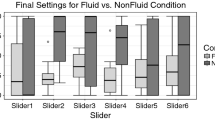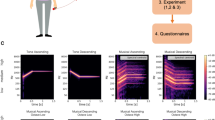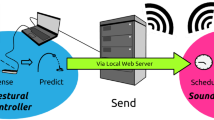Abstract
Sonification has the potential to communicate a variety of data types to listeners including not just cognitive information, but also emotions and aesthetics. The goal of our dancer sonification project is to “sonify emotions as well as motions” of a dance performance via musical sonification. To this end, we developed and evaluated sonification strategies for adding a layer of emotional mappings to data sonification. Experiment 1 developed and evaluated four musical sonifications (i.e., sin-ification, MIDI-fication, melody module, and melody and arrangement module) to see their emotional effects. Videos were recorded of a professional dancer interacting with each of the four musical sonification strategies. Forty-eight participants provided ratings of musicality, emotional expressivity, and sound-motion/emotion compatibility via an online survey. Results suggest that increasing musical mappings led to higher ratings for each dimension for dance-type gestures. Experiment 2 used the musical sonification framework to develop four sonification scenarios that aimed to communicate a target emotion (happy, sad, angry, and tender). Thirty participants compared four interactive sonification scenarios with four pre-composed dance choreographies featuring the same musical and gestural palettes. Both forced choice and multi-dimensional emotional evaluations were collected, as well as motion/emotion compatibility ratings. Results show that having both music and dance led to higher accuracy scores for most target emotions, compared to music or dance conditions alone. These findings can contribute to the fields of movement sonification, algorithmic music composition, as well as affective computing in general, by describing strategies for conveying emotion through sound.










Similar content being viewed by others
References
Dubus G, Bresin R (2011) Sonification of physical quantities throughout history: a meta-study of previous mapping strategies. Int Community Audit Disp
Winters RM, Wanderley MM (2013) Sonification of emotion: strategies for continuous display of arousal and valence. In: The 3rd international conference on music and emotion, Jyväskylä, Finland, June 11–15, 2013. University of Jyväskylä, Department of Music
Roddy S, Furlong D (2014) Embodied aesthetics in auditory display. Organised Sound 19(1):70–77
Schaffert N, Mattes K, Barrass S, Effenberg AO (2009) Exploring function and aesthetics in sonifications for elite sports. In: Proceedings of the 2nd international conference on music communication science (ICoMCS2), vol 83.HCSNet, p 86
Camurri A, Mazzarino B, Volpe G (2003) Analysis of expressive gesture: the eyesweb expressive gesture processing library. In: Camurri A, Volpe G (eds) International gesture workshop. Springer, Berlin, pp 460–467
Camurri A, De Poli G, Friberg A, Leman M, Volpe G (2005) The MEGA project: analysis and synthesis of multisensory expressive gesture in performing art applications. J New Music Res 34(1):5–21
Friberg A, Bresin R, Sundberg J (2006) Overview of the KTH rule system for musical performance. Adv Cognit Psychol 2(2–3):145–161
Ekman P (2016) What scientists who study emotion agree about. Perspect Psychol Sci 11(1):31–34
Gabrielsson A, Juslin PN (1996) Emotional expression in music performance: between the performer's intention and the listener's experience. Psychol Music 24(1):68–91
Jeon M (2017) Emotions and affect in human factors and human–computer interaction: taxonomy, theories, approaches, and methods. In: Jeon M (ed)Emotions and affect in human factors and human–computer interaction. Elsevier, pp 3–26
Juslin PN, Laukka P (2003) Communication of emotions in vocal expression and music performance: different channels, same code? Psychol Bull 129(5):770
Sterkenburg J, Jeon M, Plummer C (2014) Auditory emoticons: iterative design and acoustic characteristics of emotional auditory icons and earcons. In: Kurosu M (ed) International conference on human–computer interaction. Springer, Cham, pp 633–640
Boone RT, Cunningham JG (1998) Children's decoding of emotion in expressive body movement: the development of cue attunement. Dev Psychol 34(5):1007
De Meijer M (1989) The contribution of general features of body movement to the attribution of emotions. J Nonverbal Behav 13(4):247–268
Lagerlöf I, Djerf M (2009) Children's understanding of emotion in dance. Eur J Dev Psychol 6(4):409–431
Baulch E (2008) Music and dance. J R Anthropol Inst (NS) 14:890–935
Hagen EH, Bryant GA (2003) Music and dance as a coalition signaling system. Hum Nat 14(1):21–51
Krumhansl CL, Schenck DL (1997) Can dance reflect the structural and expressive qualities of music? A perceptual experiment on Balanchine's choreography of Mozart's Divertimento No. 15. Musicae Scientiae 1(1):63–85
Grieser DL, Kuhl PK (1988) Maternal speech to infants in a tonal language: Support for universal prosodic features in motherese. Dev Psychol 24(1):14
Hermann T, Hunt A, Neuhoff JG (2011) The sonification handbook. Logos Verlag, Berlin
Barrass S, Vickers P (2011) Sonification design and aesthetics. In: Hermann T, Hunt A, Neuhoff JG (eds) The sonification handbook, chap 7. Logos Publishing House, Berlin, pp 145–171
Edworthy J (2012) Medical audible alarms: a review. J Am Med Inform Assoc 20(3):584–589
Cvach M (2012) Monitor alarm fatigue: an integrative review. Biomed Instrum Technol 46(4):268–277
Barrass S (2012) The aesthetic turn in sonification towards a social and cultural medium. AI Soc 27(2):177–181
Russell JA (1980) A circumplex model of affect. J Pers Soc Psychol 39(6):1161
Henkelmann C (2007) Improving the aesthetic quality of realtime motion data sonification. Computer Graphics Technical Report CG-2007-4. University of Bonn
Burger B, Thompson MR, Luck G, Saarikallio S, Toiviainen P (2013) Influences of rhythm-and timbre-related musical features on characteristics of music-induced movement. Front psychol 4:183
Camurri A, Lagerlöf I, Volpe G (2003) Recognizing emotion from dance movement: comparison of spectator recognition and automated techniques. Int J Hum Comput Stud 59(1):213–225
Schubert E, Ferguson S., Farrar N, McPherson GE (2011). Sonification of emotion I: film music. In: Proceedings of the international conference on auditory display (ICAD2011)
Juslin PN, Friberg A, Bresin R (2001) Toward a computational model of expression in music performance: The GERM model. Musicae Scientiae 5(1_suppl):63–122
Juslin PN (2000) Cue utilization in communication of emotion in music performance: relating performance to perception. J Exp Psychol Hum Percept Perform 26(6):1797
Holler J, Beattie G (2003) How iconic gestures and speech interact in the representation of meaning: are both aspects really integral to the process? Semiotica 146:81–116
Busso C, Deng Z, Yildirim S, Bulut M, Lee CM, Kazemzadeh, A, Lee S, Neumann U, Narayanan S (2004) Analysis of emotion recognition using facial expressions, speech and multimodal information. In: Proceedings of the 6th international conference on multimodal interfaces (ICMI'04), ACM, pp 205–211
Guizatdinova I, Guo Z (2003) Sonification of facial expressions. In: Proceedings of new interaction techniques '03. pp 44–51
Tanveer MI, Anam AI, Rahman AM, Ghosh S, Yeasin M (2012) FEPS: a sensory substitution system for the blind to perceive facial expressions. In: Proceedings of the 14th international ACM SIGACCESS conference on computers and accessibility (ASSETS '12), ACM, pp 207–208
Zhang R, Jeon M, Park CH, Howard A (2015) Robotic sonification for promoting emotional and social interactions of children with ASD. In: Proceedings of the tenth annual ACM/IEEE international conference on human-robot interaction extended abstracts (HRI'15), ACM, pp 111–112
Canazza S, Poli G, Rodà A, Vidolin A (2003) An abstract control space for communication of sensory expressive intentions in music performance. J New Music Res 32(3):281–294
Johnson ML, Larson S (2003) "Something in the way she moves"—metaphors of musical motion. Metaphor Symb 18(2):63–84. https://doi.org/10.1207/S15327868MS1802_1
Acknowledgment
This paper is partly based on the first author's Ph.D. dissertation. The first author would like to thank his committee members, Dr. Stephen Barrass, Dr. Shane Mueller, Dr. Scott Kuhl, and Dr. Myounghoon Jeon for their invaluable feedback for this paper.
Author information
Authors and Affiliations
Corresponding author
Additional information
Publisher's Note
Springer Nature remains neutral with regard to jurisdictional claims in published maps and institutional affiliations.
Appendix
Appendix
Link to playlist of all stimuli used in Experiments 1 and 2.—https://www.youtube.com/playlist?list=PLEGYnxgyNt1A210xEjhVqkGKLecyynqkC.
1.1 Video label codes
Video label—Condition.
Experiment 1:
Reg1demo—Level 1, demonstrative gesture
Reg1dance—Level 1, dance gesture
Reg2demo—Level 2, demonstrative gesture
Reg2dance—Level 2, dance gesture
Reg3demo—Level 3, demonstrative gesture
Reg3dance—Level 3, dance gesture
Reg4demo—Level 4, demonstrative gesture
Reg4dance—Level 4, dance gesture
Experiment 2:
PCBD—Precomposed, both music/dance, Tender
PCBC—Precomposed, both music/dance, Sad
PCBB—Precomposed, both music/dance, Happy
PCBA—Precomposed, both music/dance, Anger
PCDD—Precomposed, dance only, Tender
PCDC—Precomposed, dance only, Sad
PCDB—Precomposed, dance only, Happy
PCDA—Precomposed, dance only, Anger
PCMD—Precomposed, music only, Tender
PCMC—Precomposed, music only, Sad
PCMB—Precomposed, music only, Happy
PCMA—Precomposed, music only, Anger
ISBD—Interactive Sonification, both music/dance, Tender
ISBC—Interactive Sonification, both music/dance, Sad
PCBB—Precomposed, both music/dance, Happy
PCBA—Precomposed, both music/dance, Anger
ISDD—Interactive Sonification, dance only, Tender
ISDC—Interactive Sonification, dance only, Sad
ISDB—Interactive Sonification, dance only, Happy
PCDA—Interactive Sonification, dance only, Anger
ISMD—Interactive Sonification, music only, Tender
ISMC—Interactive Sonification, music only, Sad
ISMB—Interactive Sonification, music only, Happy
ISMA—Interactive Sonification, music only, Anger
1.2 Screenshots of the pure data sonification patches
1.3 The structure and dimensions of the tracking space
See Fig. 13.
Rights and permissions
About this article
Cite this article
Landry, S., Jeon, M. Interactive sonification strategies for the motion and emotion of dance performances. J Multimodal User Interfaces 14, 167–186 (2020). https://doi.org/10.1007/s12193-020-00321-3
Received:
Accepted:
Published:
Issue Date:
DOI: https://doi.org/10.1007/s12193-020-00321-3







